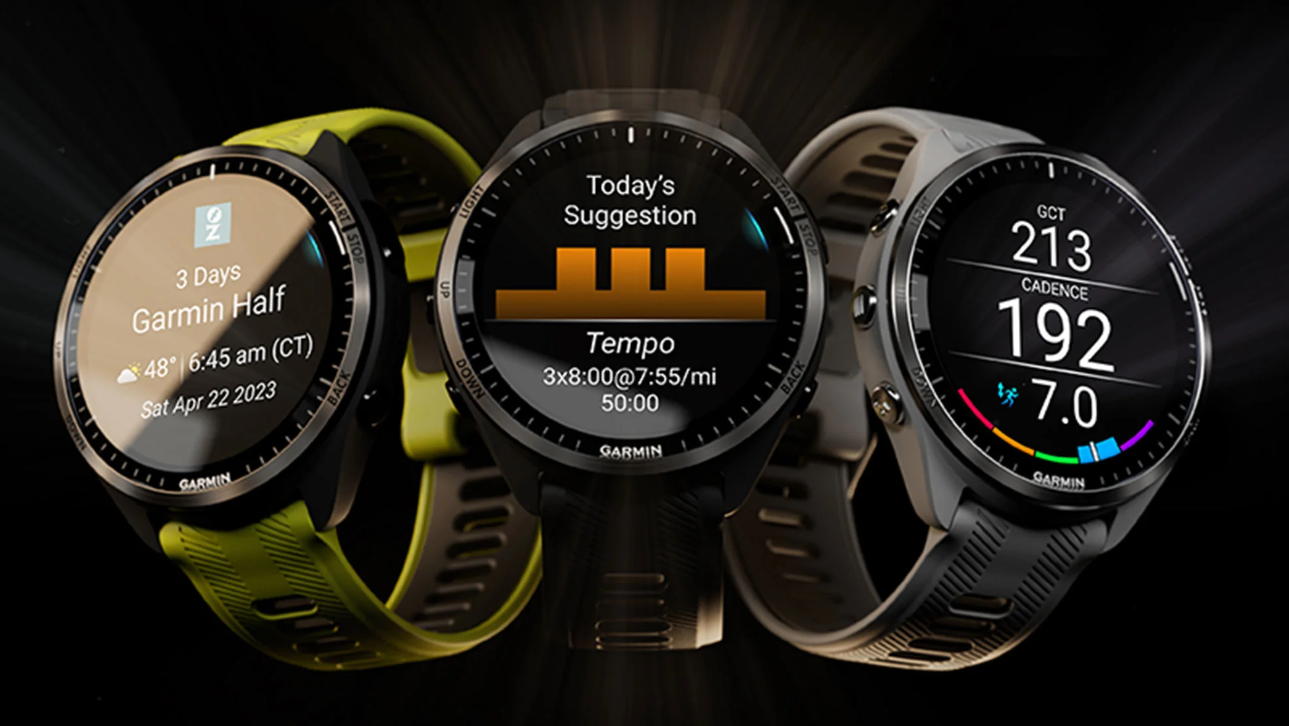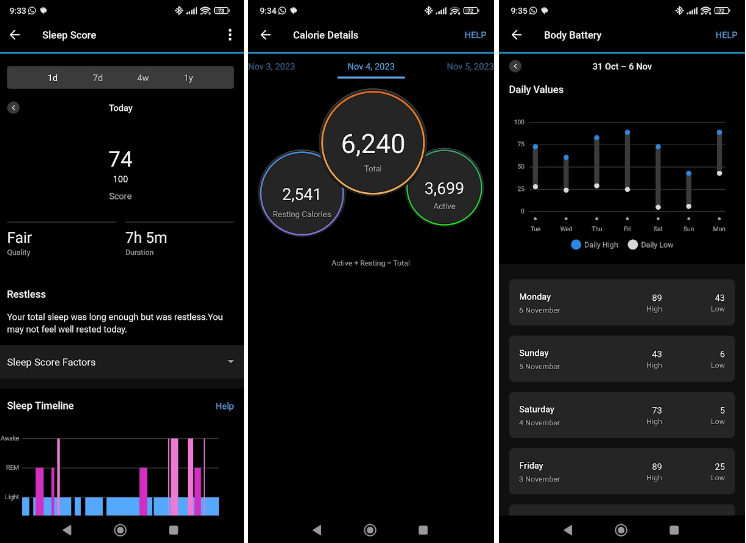The Garmin Forerunner 965 Sports Smartwatch has been ticking away for almost the hour that others call a midlife crisis, while I, on the other hand, will allow myself to look at it from a more advantageous and less mythical perspective. In a little while, I will be in the veteran category in several sports disciplines.
The signs of aging occasionally make themselves felt, so I won’t pretend to be an athlete; rather, I’ll call myself a physically noticeably used enthusiast who can push his legs and other parts of his injured body only in certain sports disciplines.

I must admit that the OLED screen of the Forerunner 965 attracted less of my attention, although it is superb in itself. In this stage of life, I am more intrigued by the built-in topographic maps. In fact, the Forerunner 965 is, if not the cheapest, one of the cheapest new sports watches with built-in free topo maps, which, together with the OLED screen, looks simply fantastic.
If we superficially compare the Forerunner 965 with the older Forerunner 955 model, design differences in favor of the new model are noticeable, but the OLED screen is not comparable to Solar charging.

In any case, one cannot underestimate the OLED screen of the Forerunner 965; it has excellent contrast, reduces brightness during sports, but never completely turns off. When you raise your arm, the screen lights up in full brightness.
Appearance and Build of Forerunner 965
As is modern now, the Forerunner 965 has a titanium frame around the screen, the watch itself feels light, perhaps a bit too light for everyday wear, but during sports, it doesn’t interfere, doesn’t catch on clothing, and doesn’t need to be adjusted periodically to the correct position on the wrist for heart rate monitoring, as is the case with my noticeably heavier Huawei Watch GT3, which I use at other times.
The Forerunner 965 uses touchscreen controls along with 5 physical buttons, a usage Garmin users are likely familiar with. I’m not very demanding, and I don’t wear Garmin every day, which makes me think that 2 or 3 buttons and a touchscreen would be sufficient to fully manage the Forerunner 965.

The Forerunner 965 also comes with a USB Type-C charging cable, although only an old USB Type-A charger is included. Overall, the Forerunner 965 demo device we received looks slightly visually worn. If a scratch on the dark titanium body is not unusual, then the unusual, shallow streaks on the beautiful OLED screen do not seem appealing. They are not even scratches; it looks more like a chemically worn protective coating.

We received the Forerunner 965 with a dark-colored body and a yellow strap. It should be noted that this watch model has interchangeable straps, but they are not the so-called quick-release easily replaceable straps, in case you are one of those who, after exercising, switch to a leather or less sporty strap for daily activities. Honestly, this seemed strange to me for such an expensive Garmin model.
Battery
The Forerunner 965 still charges with the classic Garmin connector; nothing new has been added. Perhaps some would prefer wireless charging, but then you would have to look at the Forerunner 965’s battery life with a single charge.
Approximately 2 hours of outdoor training (with GPS, steps, all sensors, connection to a smartphone, and frequent glances at the beautiful OLED screen) consume about 14% of the battery. Strong active 4 hours in the forest with all the topo maps consumed a little over 30%. Energy consumption in sports mode could be lower, as I use the built-in topographic maps quite a lot.
In daily use, the Forerunner 965 with a single charge will easily survive its three weeks, even if notifications from the smartphone are enabled. The watch even has Wi-Fi, but its use does not have any noticeable impact on battery life.
App and Smart Features of Forerunner 965
The Forerunner 965 comes with the standard Garmin Connect app, where all your sports and physical data are accumulated, and all watch settings are available. You can also download the Connect IQ app, which allows you to enhance Garmin watches with additional features and set digital watch faces.


Both on the Forerunner 965 and in the Garmin Connect app, everything revolves around and about sports. It annoys me a lot that I cannot set alarms and timers in the app; everything has to be done on the watch. Moreover, such actions are somewhat hidden because sports take precedence over everything else.


A very interesting feature (forgive me if this is not new to someone) is the morning overview of sleep and readiness for training. From the early morning, along with the alarm, you can see that Garmin recommends being active during the day. In my case, the Forerunner 965 recommends running for 45 to 55 minutes, covering a kilometer in 7 minutes and 40 seconds. This, of course, depends a lot on each person’s physical abilities and the load of the previous day.
A cool feature is the ability to see topographic maps on the screen during sports, with the north direction and your pace displayed on them. Then you can really load up to 2000 songs onto the Forerunner 965 (according to the manufacturer) and leave the smartphone at home with all the LVM GEO app maps.
Sports
As a lazy beginner, I like that in the morning, the Forerunner 965 shows recommended training paces and durations. Later in the day, you can immediately choose the pace and duration set by Garmin. However, the Forerunner 965 is quite aggressive in this regard; if you start running slowly or stop, the watch immediately vibrates, urging you to resume the desired pace. Once you’ve completed the Garmin-specified minutes, you can continue the same workout according to your preferences and abilities.

As mentioned earlier, I’m not absolutely thrilled with Garmin’s settings on the watch, and the app seems fragmented with hard-to-find settings. But once you get the hang of it, after the third or fourth time, you know where to look.

The good news, however, is that the content selection for the sports screen can be quite effectively customized. I chose the standard data screen (time, distance, pace, and heart rate), and I also have a compass view and topographic maps, which in some sports could be perceived as gimmicky.
It will be quite challenging to assess the accuracy of the Forerunner 965 sensor, but it can always be improved because the watch allows you to connect a heart rate strap. No smartwatch allows such a trick. Or at least, I can’t think of any that would allow it. If you use the Forerunner 965’s optical sensor, you can also rely on the recorded data, as the watch, along with a slightly elastic strap, securely stays in place during moderate running.
If it’s really bothering you, I was expecting the Forerunner 965 to have a slightly easier time determining the north. The watch needs to be held horizontally for about 2…3…4… seconds to accurately detect the sky. If you are in the forest and bushes, these seconds should be multiplied by two. Overall, I expected the sky to be determined faster in the forest; the watch likes to wander while capturing the north and only then correctly aligns the topographic map.

Speaking of topo maps, they are visible, zoomable, and movable before starting sports. After starting sports, you cannot affect the topo maps in any way; you cannot even zoom them, which, in my opinion, is a bit inconvenient. Also, during sports on the small screen, more information about where I have been is displayed on the map, rather than what is expected ahead.
Conclusion
With its OLED screen, battery life, and feature set, the Garmin Forerunner 965 has come close to the Epix and Fenix series in terms of build. In terms of construction, the Epix and Fenix series will still be ahead, but the price will also be completely different. However, the Forerunner 965 price is not in the budget class either.
In summary, the Forerunner 965 is a very, very enjoyable sports watch. It is light, seems durable, comfortable, and does not get dirty. For example, my Huawei watch needs a thorough cleaning and disinfection after every workout, while the Forerunner 965 is satisfied with a light wipe with a towel. I would have liked to see easily replaceable straps. Garmin offers to calculate several parameters, which I did not review here because they only start to appear after several weeks of training with the Forerunner 965; as long as the watch was with me, the HRV status, for example, was not displayed.

As perhaps could be expected, my main interest this time was in Garmin’s topographic maps. They are detailed even here, perfectly visible on the OLED screen in any conditions, but I would have liked the option to zoom the maps during sports. Of course, satellite navigation relies on satellites and almost direct visibility, so there may be delays in more wooded areas. Here I must say that the Huawei Watch GT3 performs much better with quick northern detection in wooded areas. However, the Huawei watch’s processor does not have to simultaneously struggle with drawing topographic maps because they simply do not exist.
As a smartwatch, the Forerunner 965 has its limitations, but they are not critical. Yes, you cannot answer calls on the watch. I am most annoyed by setting the alarm only on the watch (what’s wrong with putting it in the app?), as well as setting various timers, which takes unacceptably long. However, there are contactless payments, which will not be available on Huawei and Xiaomi, as they have significant limitations.
Overall, it must be said that finally, even the Forerunner series in its expensive segment has become very pleasant in terms of construction, the screen is superb, but the high price $US 599.99 also reflects improvements.





